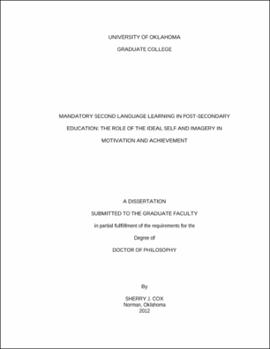| dc.contributor.advisor | Tan, David | |
| dc.creator | Cox, Sherry J. | |
| dc.date.accessioned | 2019-04-27T21:32:12Z | |
| dc.date.available | 2019-04-27T21:32:12Z | |
| dc.date.issued | 2012 | |
| dc.identifier | 99278670002042 | |
| dc.identifier.uri | https://hdl.handle.net/11244/318942 | |
| dc.description.abstract | The majority of language learning in post-secondary higher education is compulsory. Many students in compulsory L2 courses demonstrate lower than average levels of achievement and persistence. Because L2 learning is an important component of a post-secondary education in modern society, improving the motivation to learn languages can improve both achievement and retention. | |
| dc.description.abstract | Studies based upon the L2 Motivational Self System (L2 MSS) demonstrate that the variables included in the model have the potential for helping us explain motivation in L2 learning. In addition, an important component of the model is the potential of imagery in enhancing motivation. Much of the research however, examined the salience of the model's key construct rather than examining the relationships among the constructs and their ultimate impact upon second language learning. Moreover, the majority of these studies have been in settings outside the United States with students learning English as a second language and none of the studies examine compulsory language learning. | |
| dc.description.abstract | Using a quasi-experimental nonequivalent control group design, 512 college students in beginning level Spanish courses completed pre and post test surveys and an imagery treatment. Path analysis was performed to validate Dörnyei's L2 MSS in the context of US College students (English speakers) in mandatory L2 university courses. Additionally, Analysis of Covariance was performed to examine the use of imagery (ideal self and traditional cultural) to increase motivated learning behavior and intended effort as well as performance in the second language. | |
| dc.description.abstract | Data validated the L2 MSS model in a US population of L2 learners in compulsory courses. Results indicated that while all three constructs of the L2 MSS model, ideal L2 self, ought-to L2 self and L2 learning experience, were predictors of motivated learning behavior and intended behavior, they were not equal predictors of performance. Data strongly supported imagery as a priming factor that can link the utility value of learning a language to a perceived future use resulting in student reported increase in interest to learn the L2. | |
| dc.format.extent | 277 pages | |
| dc.format.medium | application.pdf | |
| dc.language | en_US | |
| dc.relation.requires | Adobe Acrobat Reader | |
| dc.subject | Language and languages--Study and teaching (Higher) | |
| dc.subject | Spanish language--Study and teaching (Higher) | |
| dc.subject | Motivation in education | |
| dc.title | MANDATORY SECOND LANGUAGE LEARNING IN POST-SECONDARY EDUCATION: THE ROLE OF THE IDEAL SELF AND IMAGERY IN MOTIVATION AND ACHIEVEMENT | |
| dc.type | text | |
| dc.type | document | |
| dc.thesis.degree | Ph.D. | |
| ou.group | Jeannine Rainbolt College of Education::Department of Educational Leadership and Policy Studies | |
